BACKGROUND
Bullying and suicidality are serious worldwide problems with negative effects on the young population and therefore international comparisons in this field are of paramount importance.
AIMS
To analyze the prevalence of bullying and cyberbullying and their association with suicidal behavior among school-aged children in Israel, Lithuania, and Luxembourg.
METHOD
In total, 3,814 15-year-olds from schools in Israel, Lithuania, and Luxembourg were surveyed in the Health Behavior in School-Aged Children (HBSC) cross-national survey in 2013/2014 using standardized anonymous questionnaires. Data analysis employed logistic regression and structural equation modeling (SEM).
RESULTS
In all, 6.5% of the adolescents reported being cyberbullied, 15.6% reported being bullied at school. In the previous 12 months, 38.6% reported experiencing emotions that stopped them from doing their usual activities, 17.8% considered attempting suicide, 12.0% made a suicide plan, and 9.5% attempted suicide. Victims of cyberbullying and school bullying had a significantly higher risk of suicidal ideations, plans, and attempts. The SEM analysis confirmed a significant overall effect of bullying on adolescent suicidality. The strongest effect was seen among Israeli students.
LIMITATIONS
The prevalence estimates were obtained by self-report.
CONCLUSION
The prevalence of adolescent cyberbullying, school bullying, and suicidal behavior is relatively high in Israel, Lithuania, and Luxembourg. Cyberbullying is a strong predictor of adolescent suicidality.
The association between cyberbullying, school bullying, and suicidality among adolescents
Suggested Citation
Zaborskis, A., Ilionsky, G., Tesler, R. & Heinz, A. (2019). The association between cyberbullying, school bullying, and suicidality among adolescents. Crisis, 40(2), 100–114.



